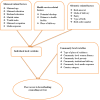Poor access to breastfeeding counseling services and associated factors among lactating mothers who had optimal antenatal care follow-up in Sub-saharan Africa: a multilevel analysis of the recent Demographic and Health Survey
- PMID: 39696253
- PMCID: PMC11654174
- DOI: 10.1186/s12913-024-12064-y
Poor access to breastfeeding counseling services and associated factors among lactating mothers who had optimal antenatal care follow-up in Sub-saharan Africa: a multilevel analysis of the recent Demographic and Health Survey
Abstract
Background: Inadequate access to services for breastfeeding counseling results in poor breastfeeding practices and adverse health consequences. Although poor access to breastfeeding counseling services is a major challenge, its magnitude and determinantes are not well studied in developing countries. Therefore, this study assessed the magnitude and determinants of poor access to breastfeeding counseling services among lactating mothers who had optimal antenatal care follow-up in Sub-Saharan Africa.
Methods: Data from the recent Demographic and Health Surveys, involving a total of 289,929 women, were used for analysis. The determinants of poor access to breastfeeding counseling services were examined using a multilevel mixed-effects logistic regression model. Significant factors associated with poor access to breastfeeding counseling services were declared significant at p-values < 0.05. The adjusted odds ratio and confidence interval were used to interpret the results. A model with the lowest deviance and highest log likelihood ratio was selected as the best-fit model.
Results: In Sub-Saharan Africa, nearly one in two women with optimal antenatal care follow-up had poor access to breastfeeding counseling services. Maternal age (AOR = 1.18, 95% CI: 1.02, 1.38), maternal education (AOR = 1.128, 95% CI: 1.22, 1.35), distance to health facility (AOR = 1.17, 95% CI: 1.13, 1.21), media exposure (AOR = 1.12, 95% CI: 1.08, 1.17), wealth index (AOR = 1.05, 95% CI: 1.00, 1.10), place of delivery (AOR = 4.31, 95% CI: 4.11, 4.52), PNC (AOR = 3.92, 95% CI: 3.78, 4.07), mode of delivery (AOR = 1.88, 95% CI: 1.76, 2.02), birth interval (AOR = 1.12, 95% CI: 1.07, 1.17), residence (AOR = 1.14, 95% CI: 1.09, 1.18), community poverty (AOR = 1.09, 95% CI: 1.03, 1.15), community institutional delivery (AOR = 1.06, 95% CI: 1.01, 1.12), country category (AOR = 2.23, 95% CI: 2.10, 2.37), had higher odds of poor access to breastfeeding counseling services.
Conclusions: Poor access to breastfeeding counseling services among lactating mothers was found to be high. Both individual and community-level factors were determinants of poor access to breastfeeding counseling services. The Ministry of Health in Sub-Saharan Africa should give attention to those women who have not had a postnatal check-up and give birth at home while designing policies and strategies.
Keywords: Antenatal care; Associated factors; Breastfeeding; Optimal; Poor access; Sub-saharan Africa.
© 2024. The Author(s).
Conflict of interest statement
Declarations. Ethics approval and consent to participate: Since this study is merely a secondary analyze of the DHS data, ethical approval is not needed. We enrolled with the DHS web archive, requested the dataset for our study, and were granted permission to view and download the data files. As per the DHS study, all participant data were anonymized at the time of survey data collection. Anyone may find more information on DHS data and ethical standards by visiting http://www.dhsprogram.com . Consent for publication: Not applicable. Competing interests: The authors declare no competing interests.
Figures



Similar articles
-
Home delivery among women who had optimal ANC follow-up in Sub-Saharan Africa: A multilevel analysis.PLoS One. 2023 Nov 30;18(11):e0295289. doi: 10.1371/journal.pone.0295289. eCollection 2023. PLoS One. 2023. PMID: 38033152 Free PMC article.
-
Bottle-feeding practice and its associated factors among mothers of children aged 0 to 23 months in sub-Saharan Africa: a multi-level analysis of demographic and health surveys (2015-2022).BMC Public Health. 2024 Jun 26;24(1):1712. doi: 10.1186/s12889-024-19244-9. BMC Public Health. 2024. PMID: 38926817 Free PMC article.
-
Minimum milk feeding frequency and its associated factors among non-breastfed children aged 6-23 months in sub-saharan Africa: a multilevel analysis of the recent demographic and health survey data.BMC Public Health. 2024 Jun 28;24(1):1734. doi: 10.1186/s12889-024-19275-2. BMC Public Health. 2024. PMID: 38943130 Free PMC article.
-
Prevalence and contributing factors of early initiation of breastfeeding (EIBF) in Ethiopia: a systematic review and meta-analysis.BMC Public Health. 2025 Apr 12;25(1):1377. doi: 10.1186/s12889-025-22568-9. BMC Public Health. 2025. PMID: 40221719 Free PMC article.
-
Uptake and determinants of routine immunization among vulnerable children and adolescents in sub-Saharan Africa: A scoping review.Vaccine. 2025 Apr 30;54:127021. doi: 10.1016/j.vaccine.2025.127021. Epub 2025 Mar 20. Vaccine. 2025. PMID: 40117940
Cited by
-
Exploring exclusive breastfeeding readiness: experiences of first-time mothers in Lusaka, Zambia.Int J Qual Stud Health Well-being. 2025 Dec;20(1):2463159. doi: 10.1080/17482631.2025.2463159. Epub 2025 Feb 9. Int J Qual Stud Health Well-being. 2025. PMID: 39924974 Free PMC article.
References
-
- Organization WH. The optimal duration of exclusive breastfeeding: a systematic review. 2001.
-
- Selim L. Breastfeeding from the first hour of birth: what works and what hurts. New York: UNICEF; 2018.
-
- Hassan AA. Maternal Vista regarding pros and cons of Breastfeeding Versus Formula Feeding. Zagazig Nurs J. 2016;12(2):149–62.
MeSH terms
LinkOut - more resources
Full Text Sources
Medical

